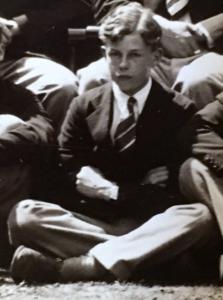
|

|
| Squadron Leader Peter John CARPENTER (36229) | |
|
519 Squadron Royal Air Force Date of birth: 28th August 1918 Date of death: 12th March 1944 Killed in action aged 25 Commemorated on the Runnymede Memorial Panel 200 |

|
| Peter John Carpenter was born at Ludlow in Shropshire on the 28th of August 1918 the youngest son of the Reverend Prebendary Thomas Lionel Carpenter MA, Rector of Culmington, and Mary Emma (nee Taylor) Carpenter of Culmington Rectory, Ludlow in Shropshire. He was educated at Lancing College where he won an Exhibition and was in Seconds House from September 1932 to April 1936. He was a member of the Hockey XI in 1935 and 1936 and was a Corporal in the Officer Training Corps achieving Certificate A in 1934. He gained his School Certificate in 1933 and 1st MB in 1935. He was appointed as a House Captain in 1936. He went on to Queens' College, Cambridge in 1936 where he achieved a BA and was a member of the Cambridge University Air Squadron. He was called up on the outbreak of war and, after further pilot training, he was commissioned as a Pilot Officer in the Royal Air Force on the 21st of October 1939, with seniority from the 21st of January 1938. He was promoted to Flying Officer on the 21st of April 1940 with seniority from the 21st of July 1939. He was posted to Bomber Command in 1940. He was married in Shropshire in 1940 to Patricia Bannerman (nee Jackson), of Clunton in Shropshire and they had a son, Christopher P., born in London on the 16th of August 1942. In 1941 he passed a course at the Advanced Navigation School with distinction and was promoted to Flight Lieutenant on the 21st of April 1941 with seniority from the 21st of July 1940. He was promoted to Squadron Leader on the 1st of June 1943. He was posted to 519 Squadron which operated as a weather reconnaissance unit based at RAF Skitten, (a satellite airfield of Wick) at Caithness in Scotland and were operating Lockheed Vega Ventura and Lockheed Hudson aircraft. Their job was to undertake long range missions for gathering meteorological data for the Royal Air Force to better plan operations further south. Missions typically lasted 7 to 8 hours often in difficult and uncomfortable weather conditions. Peter Carpenter and his crew took off at 8.54am from RAF Skitten, in Lockheed Ventura Mk 1 FN958-K for a long range meteorological sortie from Noup Head to “Point 10”. Nothing was heard from the aircraft until it called Inverness for a meteorological report at 2.17pm. At 3.21pm the aircraft called Inverness again for a navigational fix; Inverness replied with a request that the aircraft adopt a heading for the fix to be taken but no reply was received. Two minutes later they radioed again but got no reply. The aircraft was last plotted last plotted as flying at 8,000 feet and heading south at position 61 30N 00 53W in the area of the Shetland Islands, but the aircraft failed to return and no distress signal was received. Two later plots, the last of which was taken at 4.14pm and was considered to be unreliable, gave the aircraft’s height as 1,000 feet. A search was conducted by naval vessels in the area but no trace of the aircraft was found. The crew was:- Squadron Leader Peter John Carpenter (Pilot) Flight Lieutenant Bryan George Overton (Wireless Operator/Air Gunner) Flying Officer George Henry Hart NZAF (Navigator/Bomb Aimer) Flight Sergeant Clyde Thomas Young RCAF (Wireless Operator/Air Gunner) Flight Sergeant Walter Stuart Cook RAAF (Wireless Operator/Air Gunner) He is commemorated on the Cambridge war memorial in Hills Road and on the memorial at Queens' College, Cambridge. |
|
| Seconds House |
Back